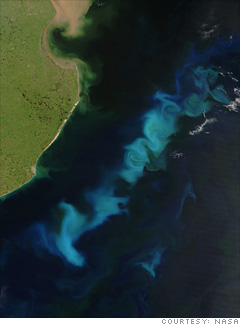
But all that carbon is making the oceans more acidic and reducing the amount carbon-sucking plankton.
How it works: This idea involves seeding the oceans with iron or other elements to stimulate plankton growth. Already, dust storms off the continents that blow iron into water are known to cause plankton blooms, seen here.
The iron is available as a byproduct of steel making, and could be dispersed for little more than shipping costs, said Dan Whaley, chief executive of Climos, a company working on the idea.
Why it might not work: Concerns remain over how additional plankton will impact the oceans. A main concern is what happens when the plankton dies? Some say it will safely sink down to the ocean floor. Others fear it will decompose near the surface, releasing its carbon into the atmosphere.
Beyond the idea: Climos is one of the few actual companies operating in the geoengineering space - most of the work is done by university professors or other researchers.
Climos' funding comes in the form of grants, but it's conceivable that some firms could make a handsome profit if any of these ideas pan out. Geoengineering schemes may qualify as carbon offset projects, where companies that emit carbon pay others to take it out of the atmosphere. Carbon offset projects may become mandatory under greenhouse gas laws.
But investors beware: Most of these ideas are far from reality.
NEXT: White deserts
